Brined Turkey Breast
With our easy brined turkey breast recipe, you can enjoy delicious and succulent poultry in just a few simple steps. The trick is to marinate it in salt water overnight – the longer you let the liquid steep into your bird before cooking, the more flavorful it will be. And you won’t have to worry about overly dry meat! We’ll walk you through preparing this dish so that all your Thanksgiving dinner guests (or weekday dinner attendees) are lined up for seconds.
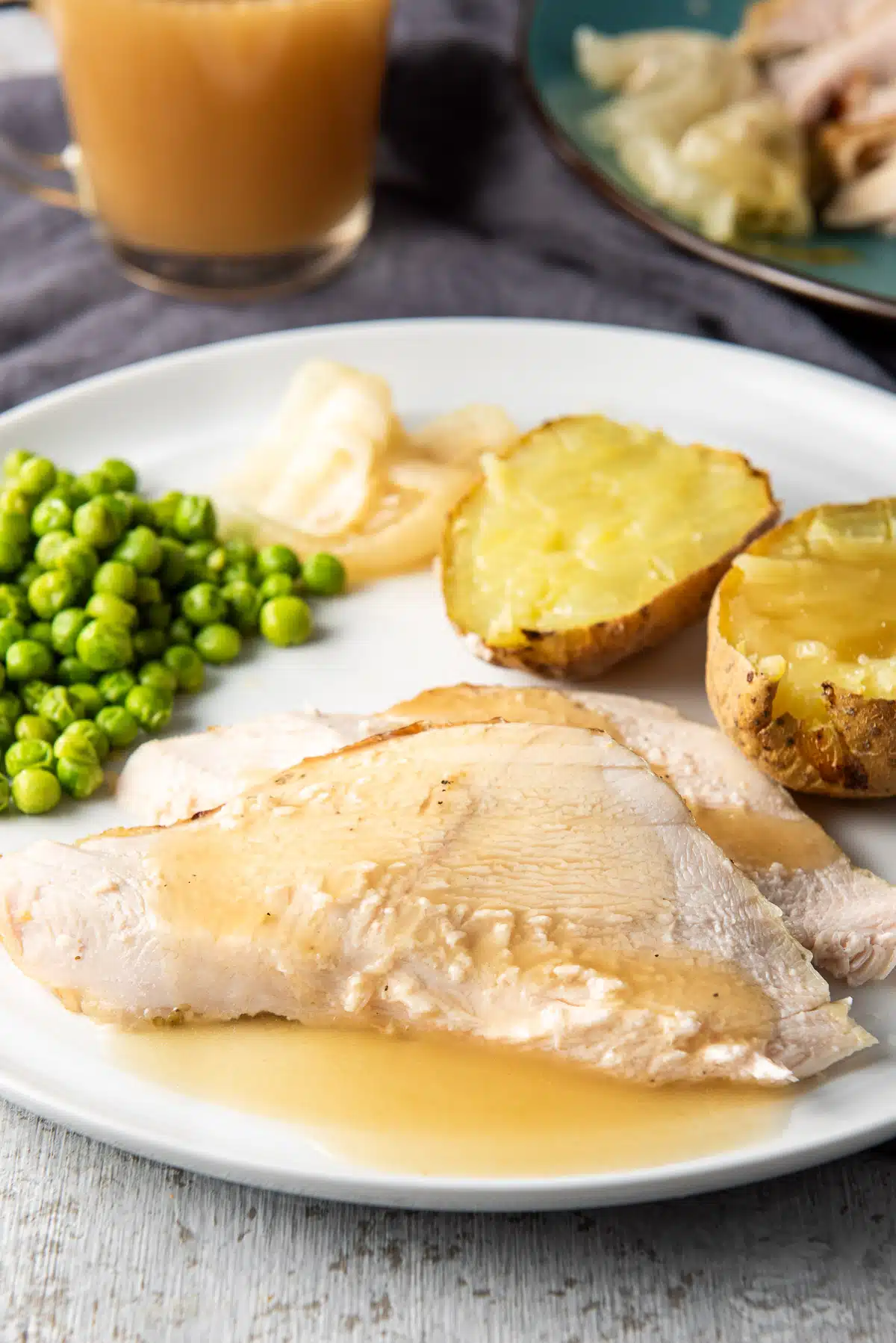
Why and how brining works
Meat is muscle and muscles are long bundled fibers. Placing the turkey in the salt and water mixture over time helps the fibers relax. The soaking of the bird allows water to enter the muscle fibers, which means when you cook the turkey, there is less water loss, resulting in moist and tender meat. Here is a good article explaining why brining works.
It is not a secret that I will always choose dark meat over white meat if given a choice. The reason for this preference is that in my experience, white meat is usually cooked too long and the meat turns out dry.
Thankfully, I was introduced to wet brine. Instead of despairing at the thought of white meat left on the platter at Thanksgiving, I know I can rejoice that the white meat I cook will be moist and delicious.
We are a participant in Amazon Services LLC Associates Program, an affiliate advertising program designed to provide a means for us to earn fees by linking to Amazon.com and affiliated sites. #CommisionsEarned. You can read my disclosure here.
Pro
Tips
- All salts are not created equal. Certain salts are milder than others. So, I use Kosher salt when brining because it’s not as salty as table salt.
- There is a difference between a turkey breast and a turkey breast roast. The breast is just the breast with the bones in, and the roast has both thigh and breast meat and does NOT have bones.
- Make sure when you brine the turkey breast that it is fully submerged.
- Brine your turkey breast in either stainless steel or plastic.
- You don’t have to bring the salt to a boil when you heat the water to melt the salt. I’ve done it both ways, and it doesn’t make a difference in taste.
- Some people put sugar in the brining mixture, but I do not as I don’t think it needs it. And don’t we already have too many foods with sugar added?
- Even though rinsing poultry is not encouraged because it supposedly spreads around bacteria, I quickly rinse the turkey after it has been brined to remove excess salt.
- If you have leftover turkey, you can store it in an airtight container in the refrigerator for up to 1 week or in the freezer for up to 3 months.
Ingredients and substitutions
- Kosher salt – Kosher salt is less dense and made of larger crystals than table salt or fine grain sea salt. But even among brands of kosher salt there can be differences. For instance, Diamond Crystal salt crystals are larger and dissolve faster than Morton’s, so if you use Morton’s, you’ll need less salt than if you use Diamond Crystal.
- Water – Filtered is best because it is purer, with less contaminants.
- Oregano – Organic ground. You can use any herb in the brining mixture. I prefer oregano or tarragon.
- Sage – Fresh sage leaves can be found in the produce section of the grocery store, near the herbs.
- Peppercorns – I use black but you can use any color you like.
- Butter – Organic. I never use margarine as I don’t trust the ingredients.
- Rosemary – Fresh sprigs are found in the produce section of the grocery store, near the herbs.
- Garlic paste – This is the best product ever. I find it in the grocery store’s produce section and use it in many of my recipes. If you can’t find the paste, I recommend using garlic powder over chopping up garlic.
- Pepper – Ground.
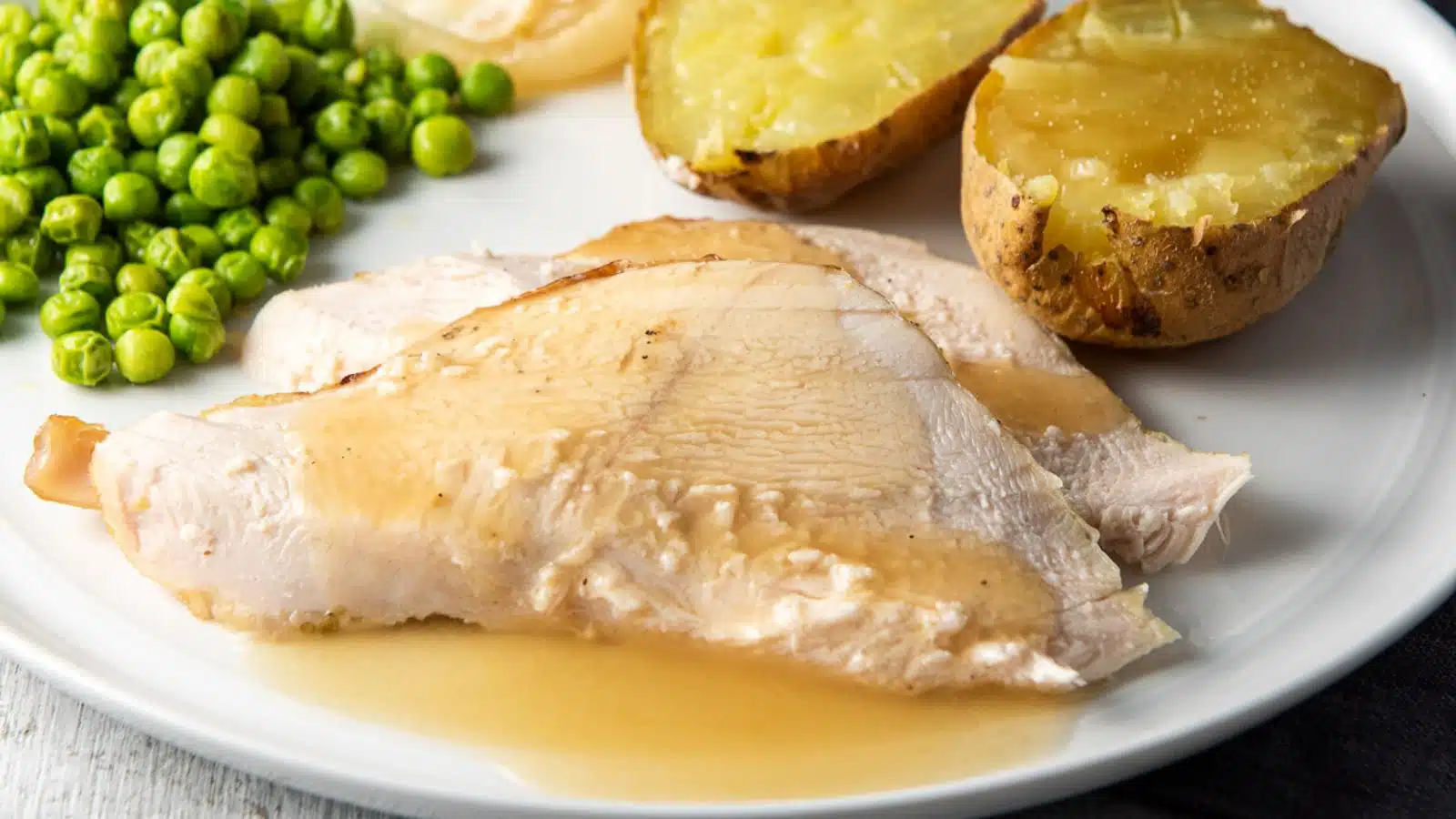
How to make brined turkey breast
Pre-step
Get out your brining container. I use my large pot which is stainless steel.
Step one
Gather the ingredients – Kosher salt, sage leaves, oregano, peppercorns, and whole turkey breast. (A)
Step two
In a saucepan, combine everything in the above photo, except the turkey, in filtered water. Set heat to medium and cook just long enough to melt the salt. Use a wooden spoon to stir until no grains of salt are left. (B)
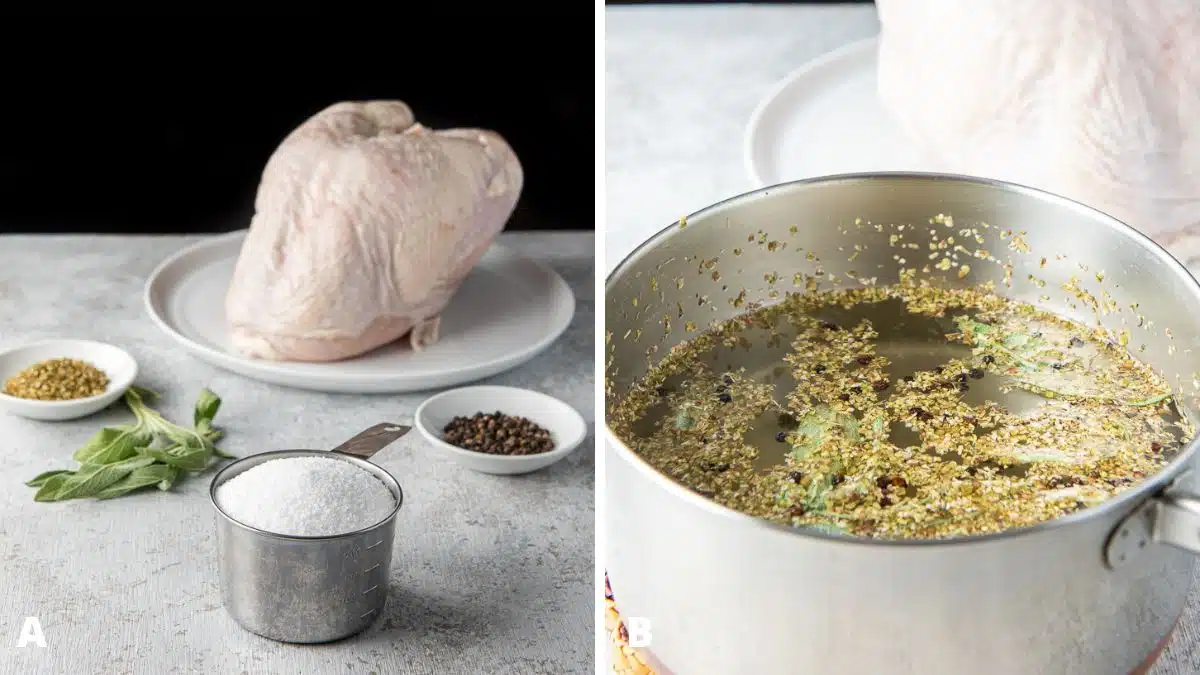
Let cool to at least room temperature. Transfer the salt mixture from the pan and put it into the fridge.
Step three
Dry your turkey breast inside and out in the brining container. Gently pour the brining mixture over the turkey. Add just enough additional filtered water to cover the turkey. (C)
Step four
Cover the container and place it in the refrigerator for at least 8 hours and up to 24 hours. I usually brine the turkey breast for around 18 hours.
Turn the turkey at least once during the brining.
Step five
Preheat oven to 325 degrees Fahrenheit.
Step six
After the turkey is finished brining, carefully remove the bird from the mixture and throw away the brining water. Rinse the bird inside and out and dry it thoroughly by dabbing at it with a paper towel. You want the skin as dry as possible so it will brown nicely.
Step seven
You can use an appropriately sized roasting pan with the V rack insert or do as I do. I thickly slice an onion and lay the slices down in a roasting pan. I do this because the drippings from the roasted turkey drip onto the onions, flavoring them so nicely.
Step eight
Place the brined turkey breast on the onions. Add four sage leaves, two rosemary sprigs, and rub butter and garlic paste on the skin. Sprinkle as much pepper as you want. (D)
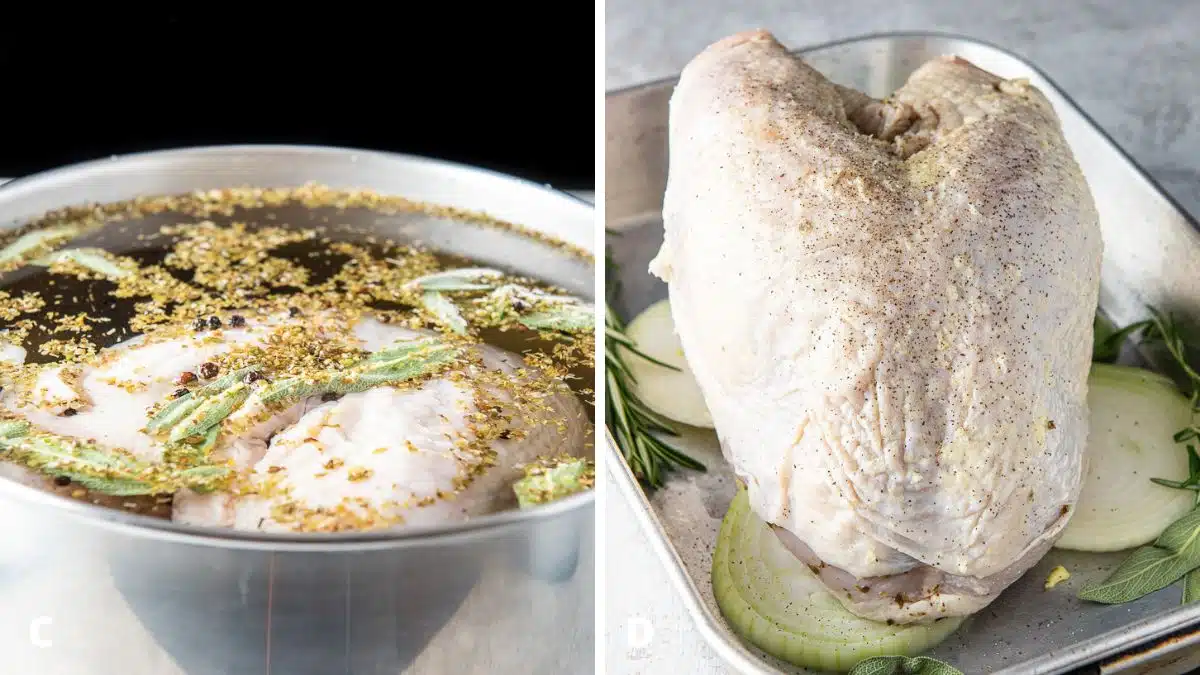
Step nine
You cook a bone-in turkey breast for 15 – 20 minutes per pound or until the temperature reaches 155-160 Fahrenheit in the thickest part of the breast.
My roast turkey breast was 5 pounds and took 1 hour and 40 minutes to reach 160 degrees F, so it took 20 minutes per pound.
Step ten
Take the brined turkey breast out of the oven and let it rest on the counter for 20 minutes before slicing. Some people place a foil tent over the bird, but I don’t bother.
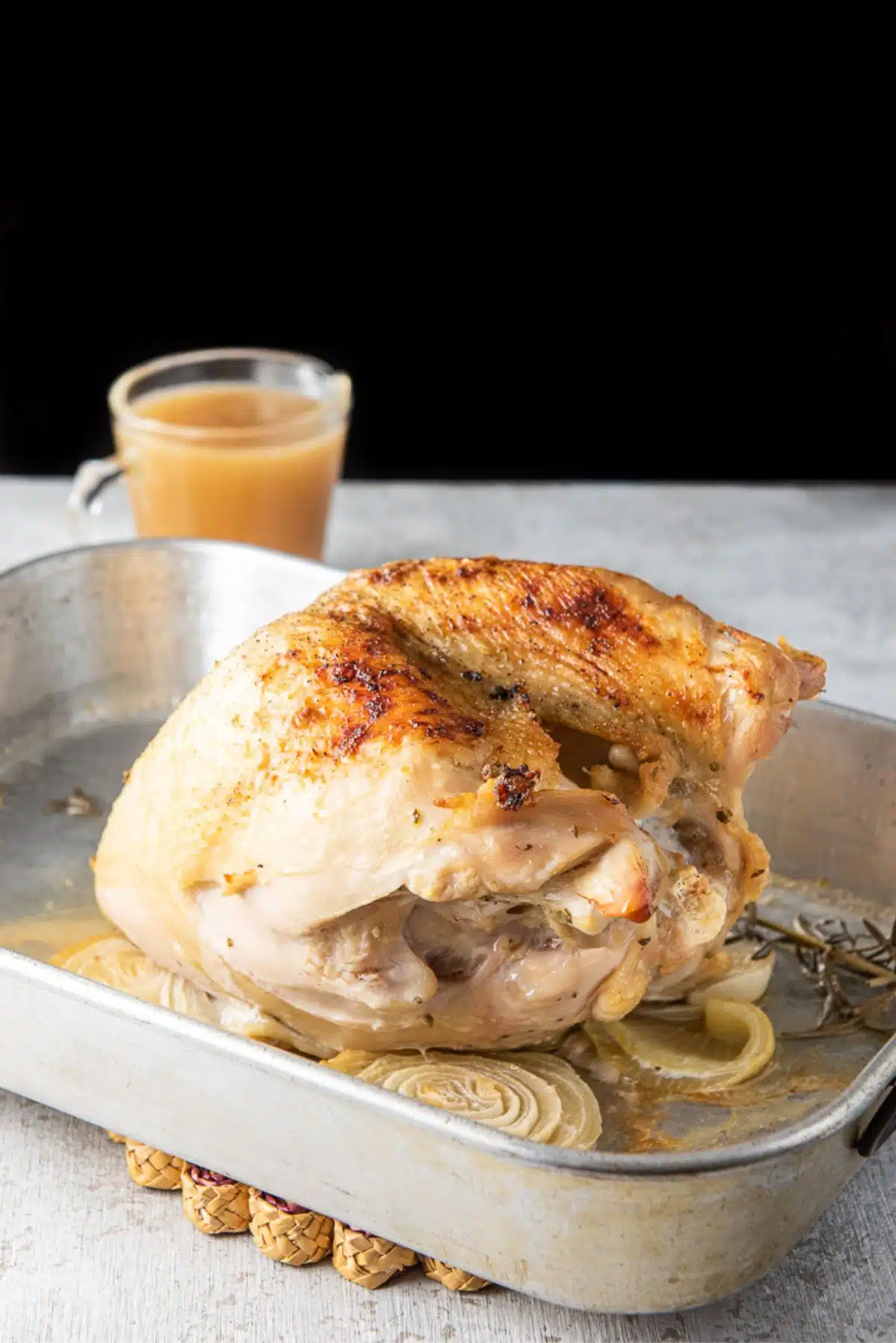
Look at those yummy onions.
Step eleven
Slice the breast as thickly or thinly as you want.
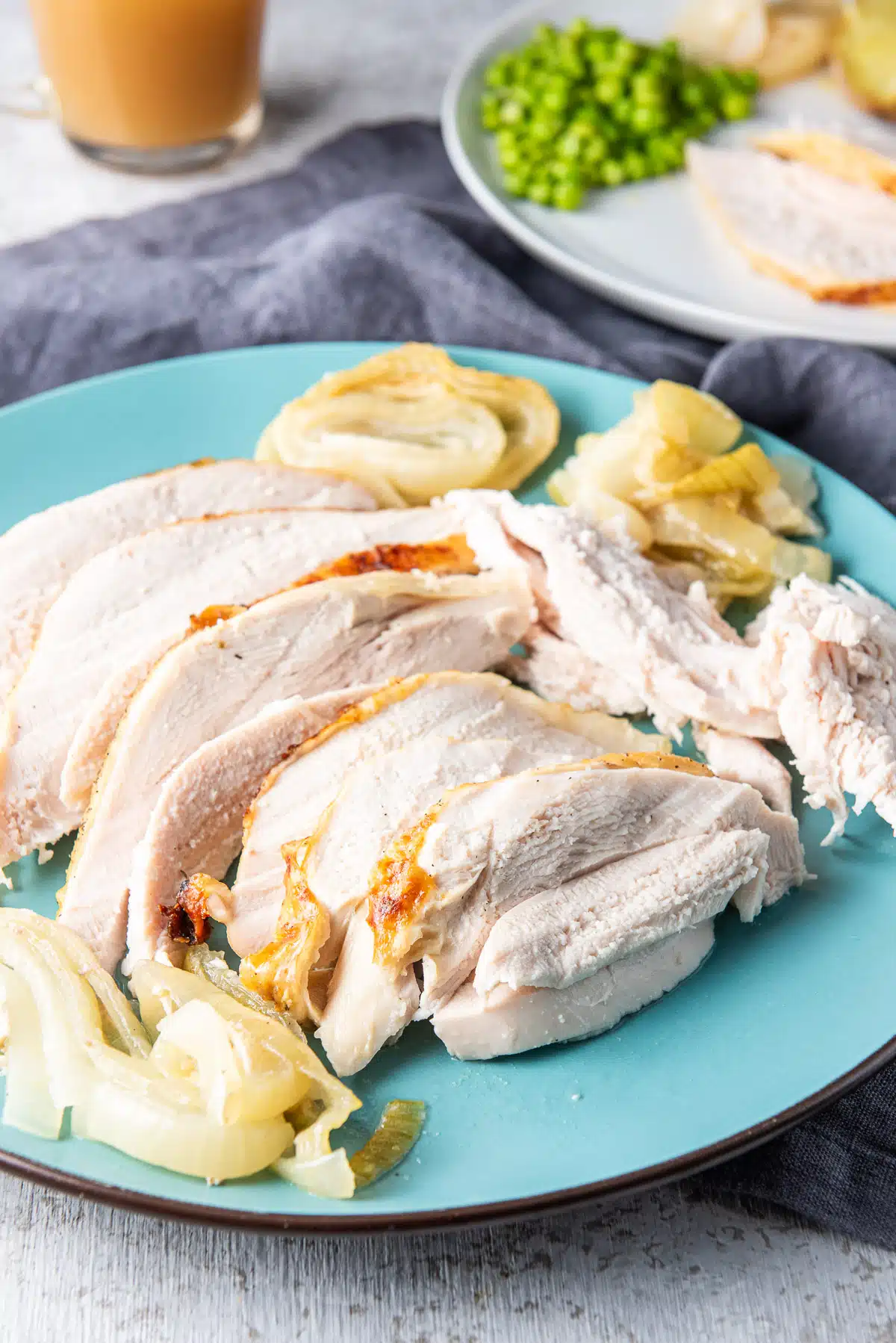
Plate a few pieces with some potatoes and veggie and pour on the gravy.

The flavor of this meat is so delicious!!
I hope you enjoyed this brined turkey breast recipe. Once you’ve brined, you’ll never go back to plain dry turkey.
Other popular Poultry recipes
And as always, may all your dishes be delish!
If you’ve tried this recipe, I’d love the know what you thought about it in the comments below. I love hearing from you! You can also FOLLOW ME on FACEBOOK, TWITTER, INSTAGRAM and PINTEREST to see more of my delicious food and delightful cocktails!
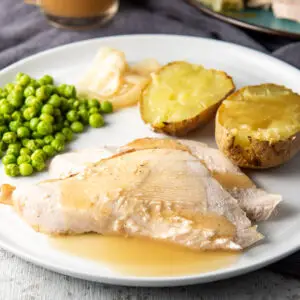
Brined Turkey Breast
Ingredients
Brining Solution
- 1 cup Kosher salt (I used Diamond )
- water
- 1 tablespoon oregano (dried)
- 8 leaves sage
- 1 tablespoon peppercorns (any color)
Bird
- 5 pound turkey breast (or as big or small as you want it)
To Bake
- 1 medium onion (sliced thickly)
- 1 tablespoon butter (approx. – enough butter to slather over the skin of the bird)
- 2 teaspoons garlic paste (enough to slather over the skin of the turkey – or garlic powder)
- 2 sprigs rosemary
- 4 leaves sage
- 1/4 teaspoon ground pepper
Instructions
Brining
- In a saucepan, add salt, oregano, peppercorns and sage leaves, and enough filtered water to dissolve the salt. Turn the heat to medium and stir with a wooden spoon until all the salt has dissolved. You should not be able to hear any scrapings of grit at the bottom of the pan. There is no need to bring the mixture to a boil.1 cup Kosher salt, water, 1 tablespoon oregano, 1 tablespoon peppercorns, 8 leaves sage
- Take the brining mixture off the heat and let it come to room temperature. I usually transfer brining mixture to a big glass measuring container and place it in the fridge for 10 minutes.
- Open the package of thawed turkey breast, remove giblets if included, and pat the turkey down with paper towels.5 pound turkey breast
- Place turkey in a big stockpot and pour cooled brining mixture over the turkey. Add enough filtered water to cover the turkey and place in the refrigerator for 8 – 24 hours. I like it to be in the brining solution for at least 18 hours.
- Preheat oven to 325 F.
- Slice onion into thick slices and place in the bottom of a roasting pan.1 medium onion
- Remove turkey from the brining solution and set aside. Dump the solution down the drain. Rinse turkey inside and out and pat dry with paper towels.
- Lay turkey breast side up on the onions and add two sprigs of rosemary and 4 sage leaves to the pan. Rub the butter and garlic paste on the skin and sprinkle pepper on the bird. If you don't have garlic paste, sprinkle garlic powder on the bird.1 tablespoon butter, 2 teaspoons garlic paste, 2 sprigs rosemary, 4 leaves sage, 1/4 teaspoon ground pepper
- Bake – between 15 – 20 minutes per pound. My 5-pound turkey breast took 1 hour and 40 minutes. Check the temperature in the thickest part of the breast. The temperature should be between 155 – 160 F. (The temperature will rise somewhat as the turkey rests).
- Let the turkey rest for 20 minutes before cutting it in slices.
- Serve
- Smile
- Enjoy
Equipment
Notes
- All salts are not created equal. Certain salts are milder than others. So, I use Kosher salt when brining because it’s not as salty as table salt.
- There is a difference between a turkey breast and a turkey breast roast. The breast is just the breast with the bones in, and the roast has both thigh and breast meat and does NOT have bones.
- Make sure when you brine the turkey breast that it is fully submerged.
- Brine your turkey breast in either stainless steel or plastic.
- You don’t have to bring the salt to a boil when you heat the water to melt the salt. I’ve done it both ways, and it doesn’t make a difference in taste.
- Some people put sugar in the brining mixture, but I do not as I don’t think it needs it. And don’t we already have too many foods with sugar added?
- Even though rinsing poultry is not encouraged because it supposedly spreads around bacteria, I quickly rinse the turkey after it has been brined to remove excess salt.
- If you have leftover turkey, you can store it in an airtight container in the refrigerator for up to 1 week or in the freezer for up to 3 months.
Nutrition
From lighting up stages with her BA in theater to food journalist, Elaine Benoit's journey is a testament to passion's transformative power. As the CEO of Dishes Delish, she offers a blend of healthy, comforting recipes and exquisitely crafted cocktails. Beyond the kitchen, Elaine voiced her culinary adventures on her podcast, "Dishing," and co-owns Food Blogger Help, extending her expertise to guide budding food bloggers to success. Whether it's for a heartwarming dish or insights into food blogging, Elaine's diverse experiences make her a beacon in the culinary digital landscape.

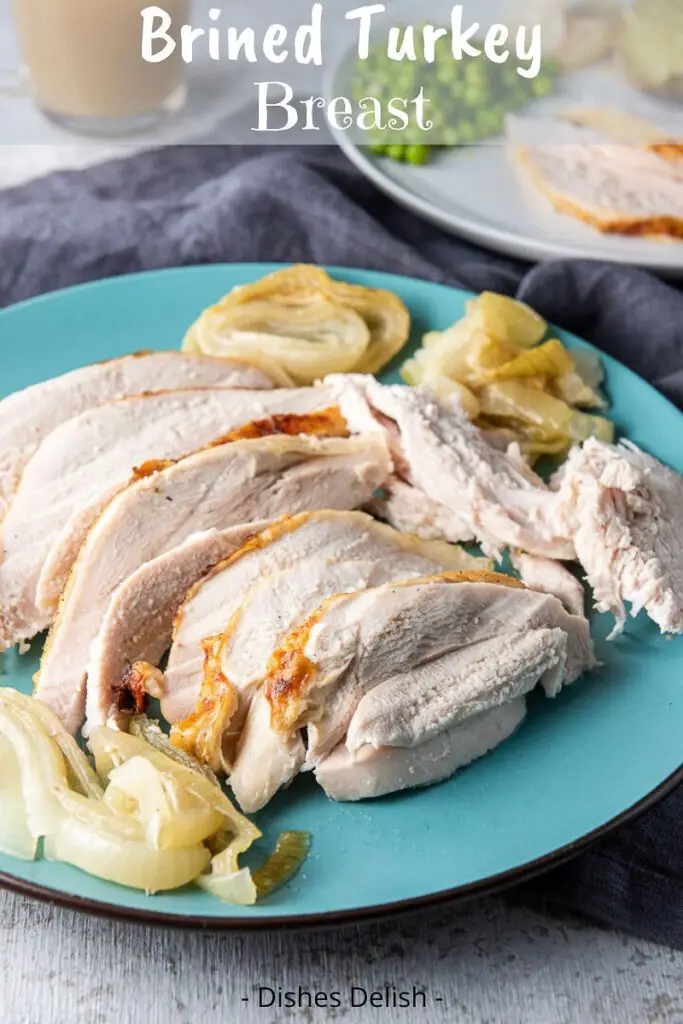
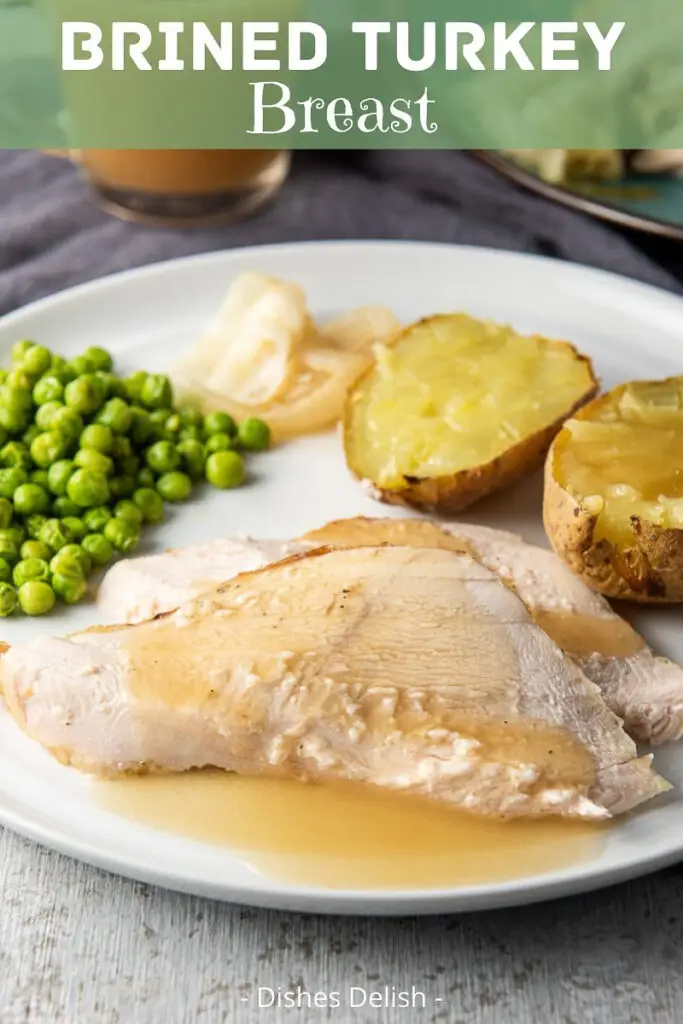
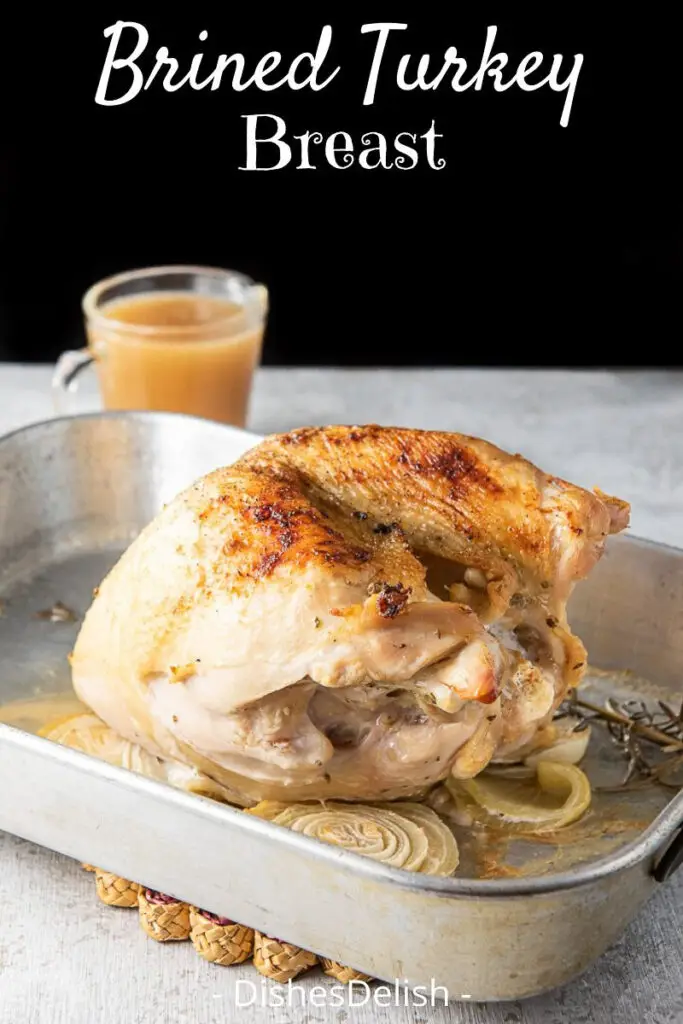
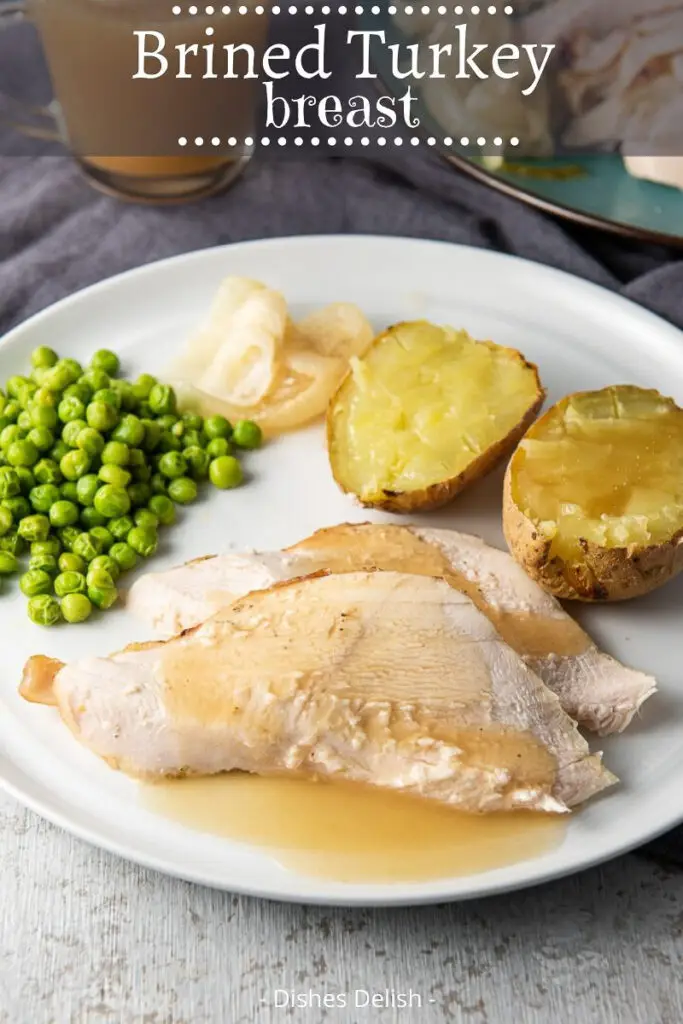
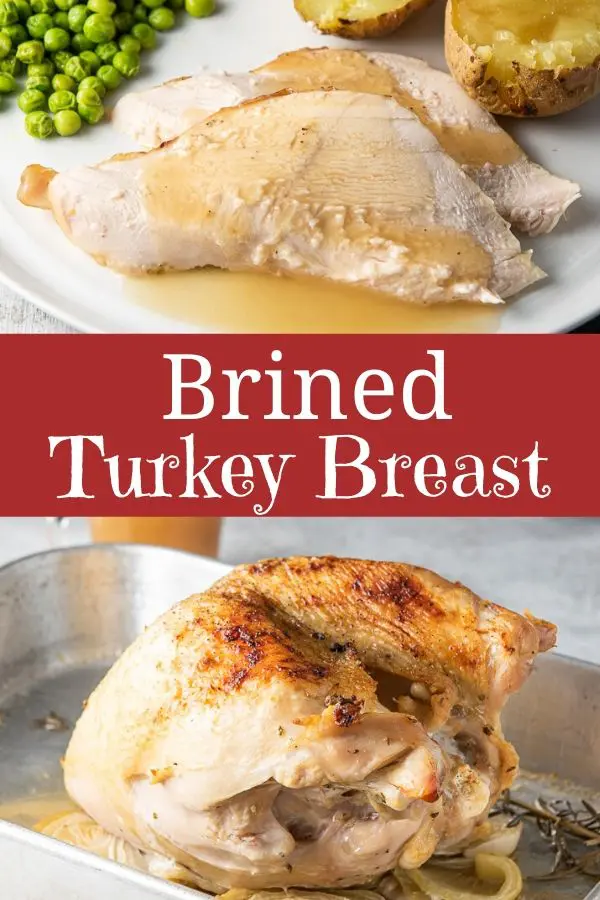



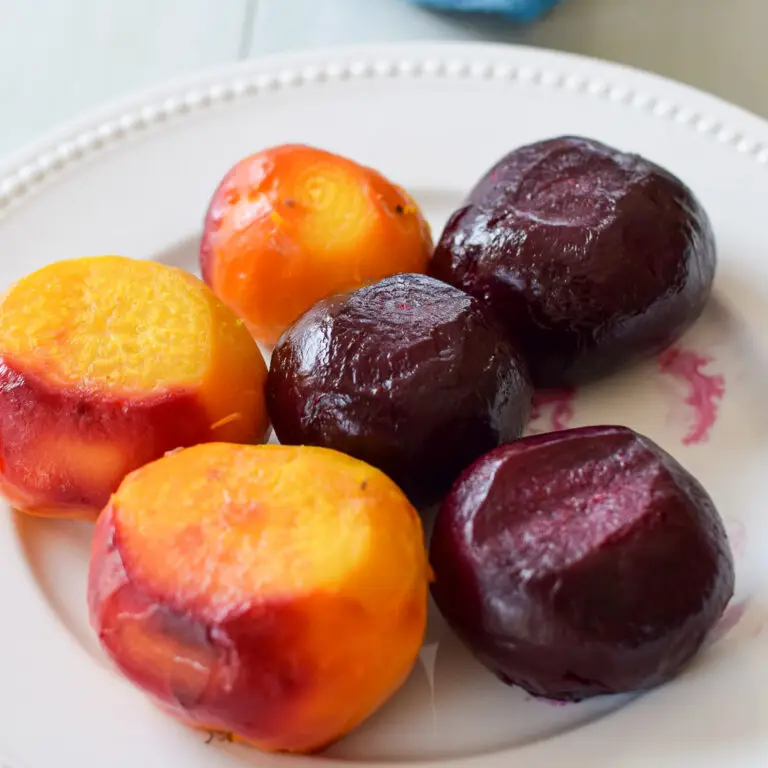
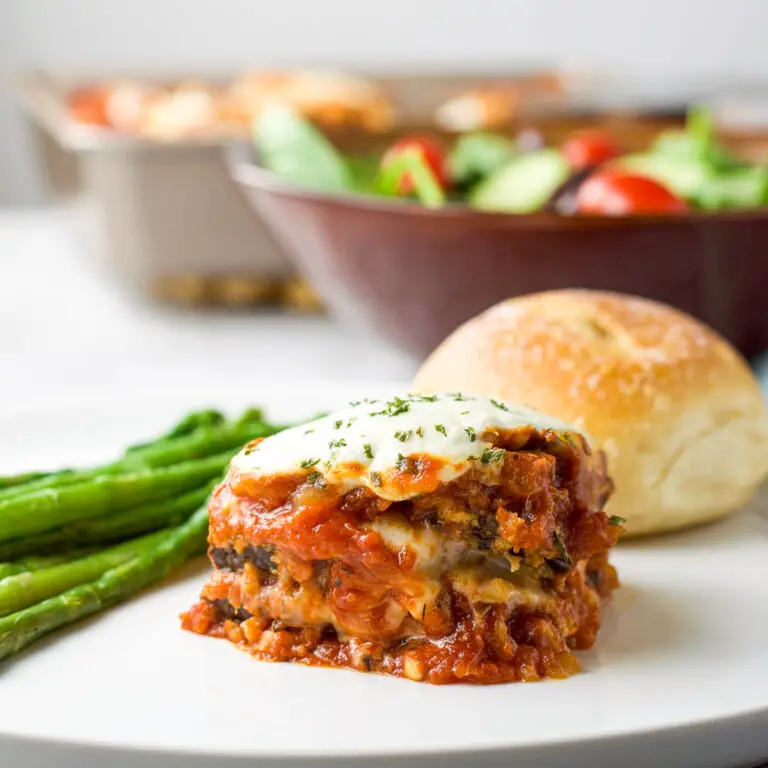
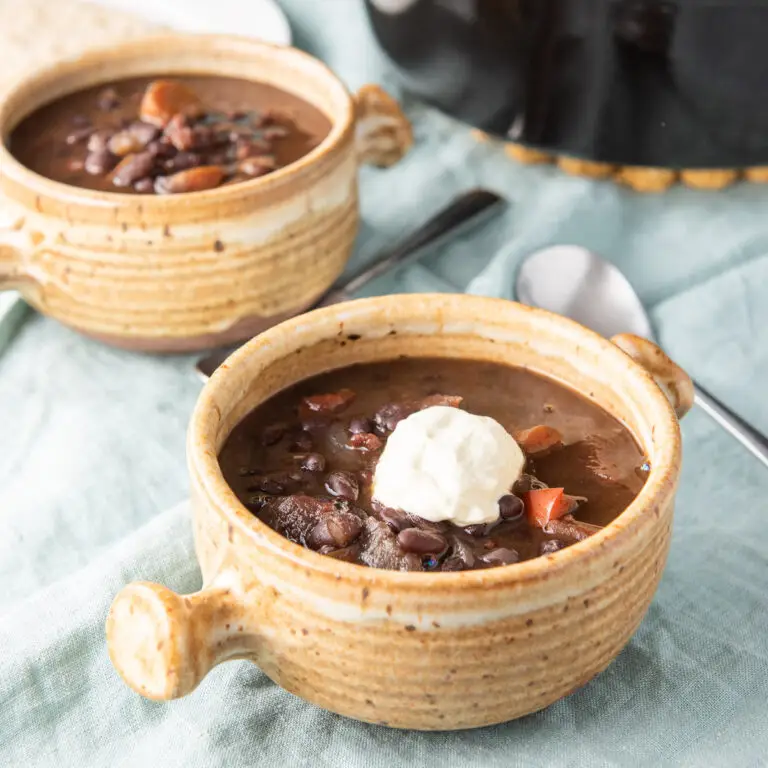
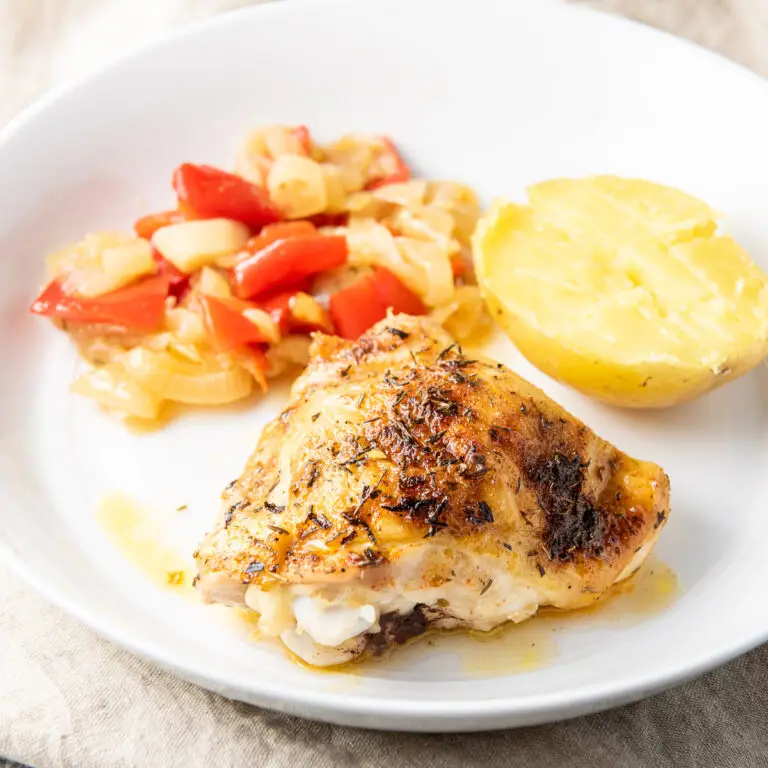
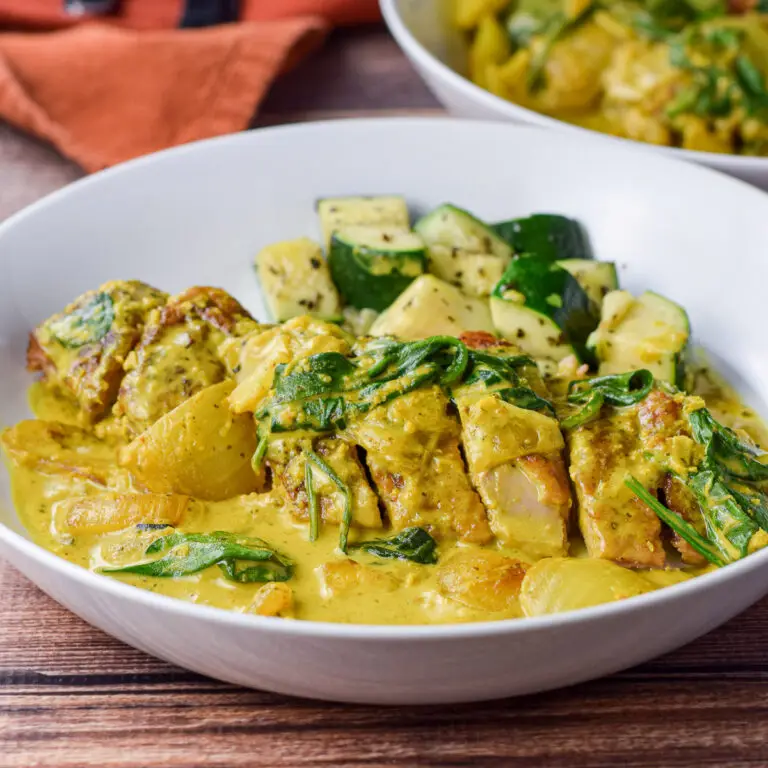
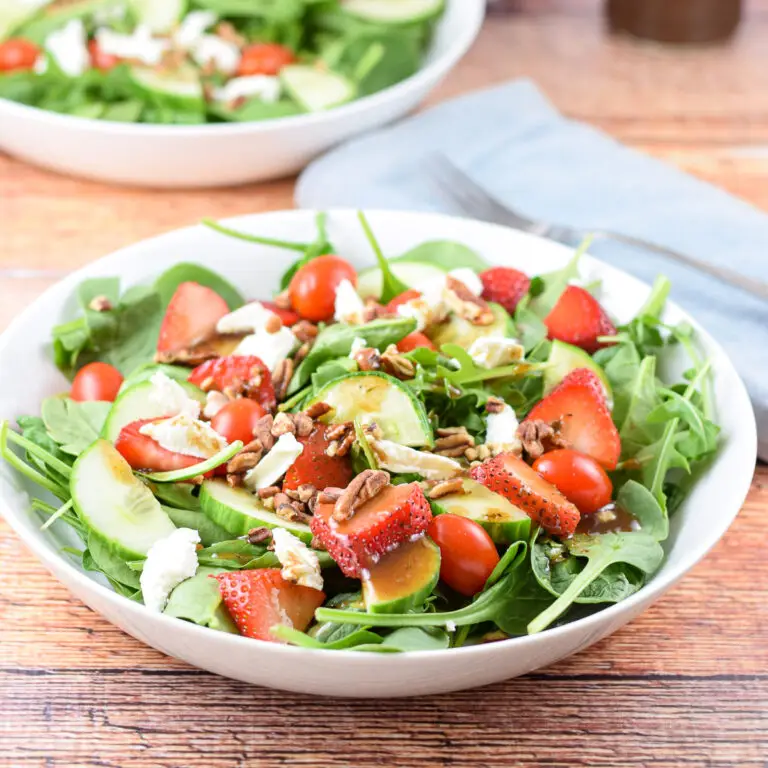
Love how easy and delicious this recipe is. It’s perfect for a gathering or a party.
Thank you Shadi! 🙂
Brining definitely makes for the most juicy, tender turkey. I love the sage in your brine. So delicious!
Thanks Raia! I love sage and try to put it in everything. 🙂
Your step by step tips are such a big help! Such an easy, delicious way to enjoy turkey!
Thanks so much Marlynn! I appreciate it.
Perfect timing for Thanksgiving coming up! Delicious, thank you!
Thanks so much Noelle!
This would be great for our Christmas Day roast.
Thank you Dannii! It would be!
Stellar I bake only the turkey breast too because nobody at home likes the dark meat and brining is the way to go to make it moist, Pinned!
Thanks Adriana. I love the breast for sandwiches! 🙂
All these herbs and seasonings pair perfectly with turkey. I’ve never brined a turkey breast before, but I most certainly want to now. Thanks for your easy guide on how to.
Thank you Michelle. You will be surprised on how easy it is! 🙂
I’m going to have to give this a try. I’ve never tried brining before, but I’ve heard it really gets the meat tender.
It really does Ben. Thanks for your comment! I hope you enjoy it when you try it.
We always brine our turkey, it really does make a huge difference! Will try your recipe this year!
Thanks Carrie! I love how moist the meat gets!
I love brining my turkey as well. I love that you also only use the turkey breast and not the whole bird. I rarely make a whole bird and no one here really is a big dark meat fan. Gorgeous shots and I love the easy instructions!
Thank you Lori! I’m actually a huge dark meat fan and will only eat breast meat that’s been brined! 🙂 So the next time you brine a whole turkey, invite me over and I’ll take care of the dark meat for you! 😉
That turkey breast looks so flavorful and delicious! Definitely going to try your recipe.
Thank you Denise!
I’m in total agreement! Brining really helps with adding not only taste but moisture to the bird. We’ve brined both just the breast and also the entire turkey. It is the secret to a fantastic meal. Your seasonings are right on the mark.
Thanks so much Marisa! I really appreciate it.
What an incredibly helpful step-by-step post! And I love your description of each ingredient; i am a HUGE Diamond Kosher salt girl (thank you Chrissy T), but it’s hard to relay the reduced potency of that salt v. other salts. You did it all in this post though!
Thanks Sara! I appreciate it. Diamond Kosher is my favorite. Although, I do like Maldon flakes as well!
Such an easy recipe for a crowd. Love it totally.
Thanks Gunjan!
I love brine meat, it keeps the flavors locked in and meat is so moist and tender. These turkey breasts looks absolutely delicious!
Thank you so much Jo! 🙂
You and I are on the same page with brining our turkeys! There really is no better way to tenderize and flavorize that turkey breast. Yum!
Yay! Thanks so much Amy!
Hey Lainey, This looks yummy especially since I’m one of those people who can’t get the timing right and always end up over cooking the breast meat 🙁
I already bought a turkey breast roast. Do you know if brining would work with this or do you have to have the bones to make it work right?
Hey Devie, I have done it with the turkey breast roast and I’ve brined it. The difference is, if I remember correctly, since it doesn’t have the bones, I think I cooked it 10 minutes less, so around 1 hour and 30 minutes – so that comes to 20 minutes per pound. If you have a digital thermometer, the temp should be 160 – and let it rest for 10 min before cutting. I love brining it because it keeps the meat moist which helps as I hate dry breast meat!! Also, leave on the twine casing to keep it together while you’re cooking it. Let me know how it goes. Miss you! xo